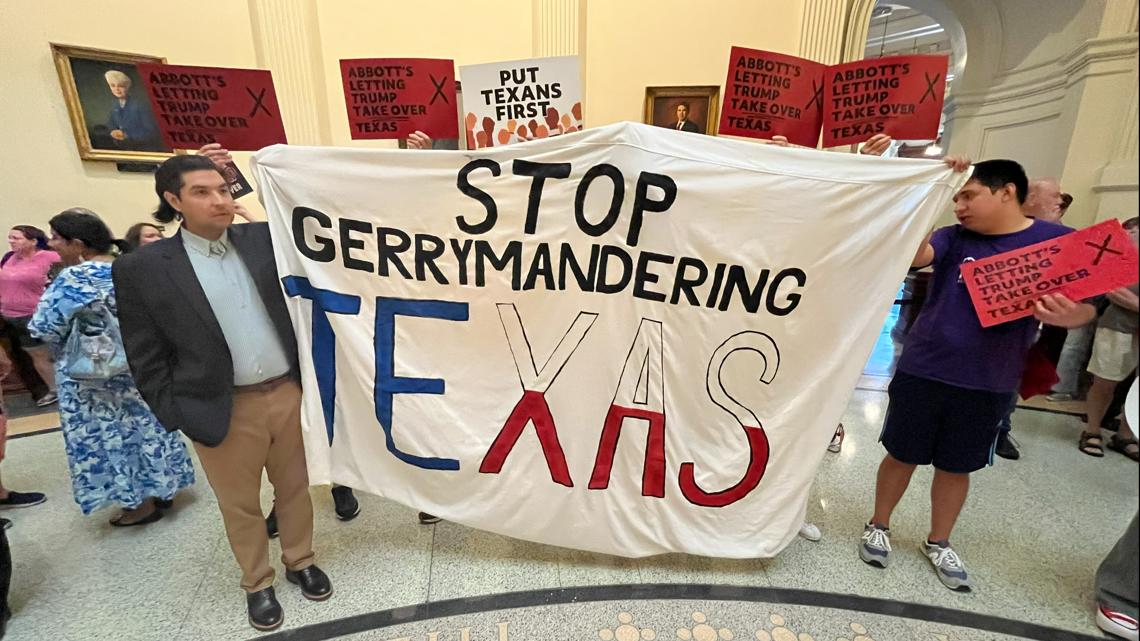
The redrawn map shifts around voters in Austin, Houston, North Texas and the Rio Grande Valley in hopes of creating five more Republican seats in the U.S. House.
AUSTIN, Texas — Hundreds of Texans gathered at the Texas Capitol on Friday to provide feedback on proposed changes to the Texas congressional district map.
The line to get into the House Select Committee on Redistricting public hearing on House Bill 4 by State Rep. Todd Hunter (R-Corpus Christi) stretched down the hall and into multiple overflow rooms. Buses full of people came from all over the state to share their thoughts with state lawmakers.
The hearing got tense at times as Democrats questioned Hunter about the proposed map.
The push to redraw the congressional district map follows President Donald Trump’s urging of Texas Republicans to redraw the congressional districts to secure five more Republican seats in the U.S. House of Representatives.
Hunter made clear that the driving forces in how they drew the new districts were political performance and compactness.
Drawing districts for partisan gain or political advantage is legally permitted under previous Supreme Court rulings.
“Different from everyone else, I’m telling you,” Hunter said. “We have five new districts, and these five new districts are based on political performance.”
Based on the proposed new map, President Trump would have won 30 of the state’s 38 congressional districts in the 2024 presidential election by at least 10 percentage points.
Hunter said that the proposed map doesn’t racially gerrymander and adds districts that are majority Hispanic and Black. Democrats criticize the redraw as being conducted on racial lines.
“This plan includes political considerations,” Hunter said. “The public testimony from the hearings, population growth which has occurred and recent changes in voter trends.”
Almost all, 37 of the 38, congressional districts in Texas are changed to some degree.
In the new map, District 35 no longer stretches from Austin to San Antonio, but instead from Guadalupe County down to San Antonio and east of Interstate 35.
“What really is going on here is that the Hispanic population in Bexar County and Austin is enough to allow for two highly compacted districts with a sizable Latino population, and instead we just have one,” State Rep. Josey Garcia (D-San Antonio) said.
That district is currently represented by Congressman Greg Casar (D-Austin), but under the proposed map, he would have to face off with long-time Congressman Lloyd Doggett (D-Austin), who represents the current District 37.
“Trump is demanding that we create districts that make no sense,” Rep. Greg Casar (D-TX 35) said. “The southern part of the Austin metro area gets gerrymandered into Port Aransas. Northern parts of the city get gerrymandered into Midland Odessa. That is tearing apart my home, my community, to preserve the billionaire’s power.”
Hunter said the new District 35 is more compact and is now a Hispanic majority district, which it was not when the current map was drawn in 2021.
To create the five new Republican seats, the proposed map shifts voters in Austin, Houston, North Texas and the Rio Grande Valley. It puts more Democrats into already Democratic-held districts in some of the state’s biggest cities, such as San Antonio and Houston. Democrats would have larger margins in U.S. Reps. Jasmine Crockett, Joaquin Castro and Sylvia Garcia’s districts, but they moved around Republican voters from red districts to other Democratic districts, like Casar’s and North Texas U.S. Rep. Julie Johnson’s.
“What they’ve done is they’ve taken those minority communities, and they’ve separated them. They’ve either divided them into random districts that have nothing to do with the things that they need,” Rep. Jasmine Crockett said. “They’re not communities of common interest, or they’ve packed them into districts, and now they’re claiming, oh, we created a new something for you, so be happy, and it’s not true.”
Under the proposed map, 24 districts would comprise a majority of white residents who are eligible to vote, an increase of two from the current map. The map would add one Hispanic-majority district, bringing the total to 8, and create two new majority-black districts.
Four out of five of the districts that Republicans are hoping to flip are majority Hispanic.
“It does not look good when you take every economic engine out of my district and then tell me that I am supposed to sit here and be so happy because you added black folk from a whole other community when you want to talk about monoliths and whether or not they exist,” Crockett said.
The U.S. Department of Justice has also raised concerns about the state’s current map, which was drawn in 2021 and 2023, saying four districts were drawn based on race. However, Republican lawmakers have stated that this is not the case, claiming the map was drawn fairly.
Hunter, who was involved in drawing the 2021 and 2023 maps, said he filed the bill at the request of committee chair Cody Vasut (R-Angleton) and that the letter had nothing to do with it.
“That’s not guiding me. I’m presenting a plan, and they can then review the plan and if they believe that I’ve addressed issues, good, if they believe I haven’t, good,” Hunter said. “Whatever they’ve sent. I’m not ignoring it; I’m not accepting it. I’m following this plan. So whatever their involvement is, they just send a letter as far as I’m concerned.”
Democrats slammed the proposed map as racist and illegal, saying it will dilute the voting power of communities of color.
“It feels a little like McCarthyism, why we’re here today,” State Rep. Christian Manuel (D-Port Arthur) said. “Are their seats or their positions to be able to speak out in jeopardy because they won’t follow along with what the current administration is doing, because it does feel like certain communities are being attacked because they won’t submit?”
In response, Hunter said that is not the case.
Political maps must be redrawn once every decade after the U.S. Census is taken, although no federal law prohibits those maps from being redrawn mid-cycle. The Texas Constitution allows the maps to be redrawn at the discretion of the governor and the Legislature.
The Trump administration wants Texas to redraw its maps to carve out more Republican seats, thereby increasing the GOP’s advantage in the U.S. House, which they currently control by a slim margin of 220-212. The goal is to make it easier for Republicans to maintain control of the House in the upcoming 2026 midterm election, when the party could face significant political headwinds.
To create new Republican seats, Republicans may have to dilute and stretch GOP voters thin, turning safe districts into swing districts. It is known as a “dummymander,” and it could make incumbent Republicans more vulnerable, particularly in a midterm election environment, if Republicans are not careful in how they draw the new districts.
“Each of these newly drawn districts now trends Republican, and political performance doesn’t guarantee electoral success,” Hunter said. “That’s up to the candidates, but it does allow Republican candidates the opportunity to compete in these districts.”
Republicans hold 25 of the state’s 38 congressional seats. Democrats hold 12 and are one seat is currently vacant following the death of Sylvester Turner back in March .
Adding five more GOP-leaning seats in Texas would likely give Republicans control of 80% of the Texas delegation in the U.S. House.
“As Texans, we should support redistricting not to gain advantage, but to make sure every Texan is fairly and equally represented,” Lisa Dyer said. “Supporting redistricting is about fairness, accountability, and respect for our constitution. It’s not just about lines on a map. It’s about making sure that each voter carries equal weight, that each vote carries equal weight, and that every Texan, no matter where they live, has a voice.”
Supporters of mid-decade redistricting argue that it is necessary to keep pace with Texas’s growth.
“Families are moving in and towns are growing, and communities that used to be small are now booming. Redistricting is how we keep up with that change,” Melinda Preston, the chair of the Denton County Republican Party, said. “This means growing communities don’t get left behind, and rural voices, which have always been about the backbone of Texas, still carry weight in our government. This isn’t about one party or another. It’s about being fair, being smart, and being true to our Texas values. It’s about responsibility, accountability, and standing up for what’s right.”
Before a proposed map was available, the House committee held three field hearings across the state to get public input. Democrats want more field hearings now that there is a proposal, but Committee Chairman Rep. Cody Vasut said there are no plans for that.
State Rep. Senfronia Thompson (D-Houston), who has served in the Texas House for 53 years, took issue with that decision.
“We always had public input on the maps. We have always allowed them to see those maps. We have always had field hearings where they can have input. Whether we consider input or not, we gave them those opportunities,” Thompson said. “I have never, never, never seen it done this way.”
The 2021 state legislative and congressional maps have faced legal challenges, with some arguing they discriminate against some Black and Latino voters. The case went to trial in El Paso last month; however, a ruling is not expected for several months.
The plaintiffs in that lawsuit argue that the special session call and the DOJ letter contradict what the state has long maintained – namely, that race was not a factor considered in drawing the district boundaries in 2021.
Any new Texas map approved by lawmakers will likely face significant legal challenges.
Vasut said he expects the committee will vote on the proposed map either late Friday night or on Saturday, and for it to come up for a vote on the House floor on Tuesday at the earliest.
